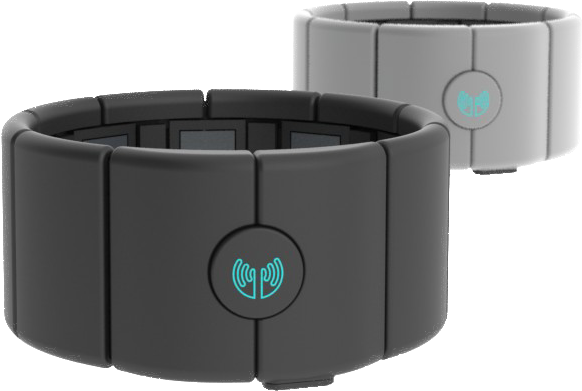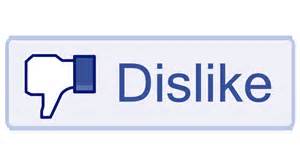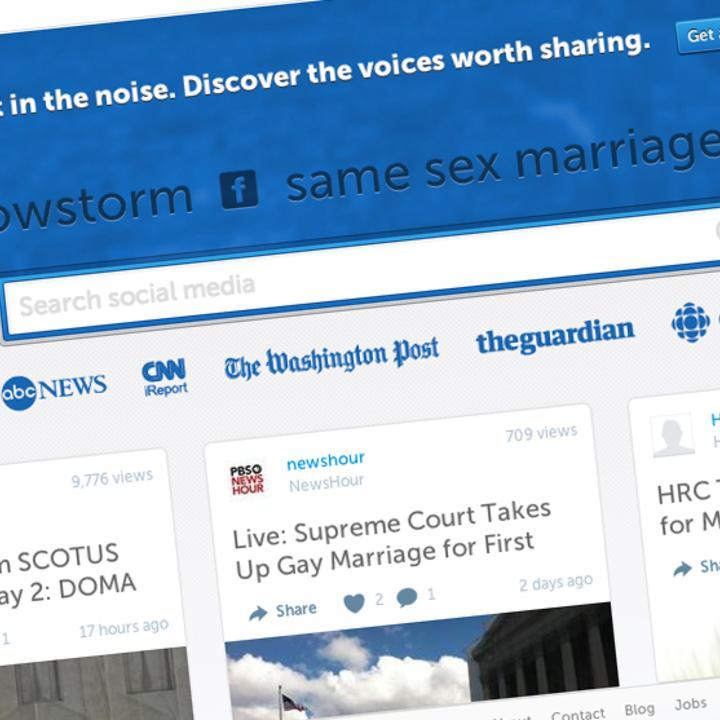The MYO Armband
A couple of months back I came across the MYO armband in the news. There was brief description of the product included along with a short history of how it came to be. I read through the article and my interest was piqued, but only marginally. But then I watched the video that they added directly from the developer’s website. Now, not only is my interest piqued, I’m hooked on this thing.
For those of you who have not heard of it before, the MYO armband is a piece of wearable technology that allows you to control your Windows or Mac computer. It slides on and sits snugly in the middle of your forearm. This allows the armband to be in a position to register the muscle movements in your arm that act as the input control for the device to your computer. So for example, the armband would pick up on you twisting your hand to the right while balled up in a fist which would send a signal to your computer to turn up the volume of the music that’s playing. Pretty nifty stuff.
The video highlights many ways that the armband could be used. It shows someone playing their favorite video game (mine too: Mass Effect) using the armband as the primary control with arm movements. Then there’s a person giving a presentation using the MYO armband to “swipe” between Powerpoint slides in mid-air (the presenter also does some other really cool stuff but I’ll let you watch the video for yourself to see it in action). Another individual is in their kitchen cooking and uses the MYO armband to pause and rewind a cooking video for the meal they’re preparing. Now we can avoid getting all those raw chicken juices all over the keyboard!
As mentioned previously, I am extremely interested in the MYO armband. I see it as a remote control that interfaces with your computer. But instead of pushing buttons, it uses your arm and hand movements. I would love to have one of these things and its more reasonably priced that expected ($150). Unfortunately there are a few things preventing me from getting one:
-
The next batch of pre-orders don’t ship until early 2014.
-
While $150 is reasonably priced, its more than I have disposable at this time to be an early adopter of it.
-
While I’m in love with and like to think about all the possibilities for using it, as I look at my everyday life it appears that it would be seldom used so the return on investment would be low.
This does not discourage me about the prospects for the armband though or the company developing it. I’m not an early adopter (only because of no extra available income, the desire is there) not in a profession that would allow immediate and frequent implementation of the product. So I’m not their target audience. But I am interested in the product and support their desire to be successful.
While the product is currently only fully functional with Mac and Windows computers, the developers are working to have it usable with iOS and Android devices. I think this will be critical in order to have a greater target audience of potential users. For more information about the MYO armband, see their website here: https://getmyo.com.
What do you think of the MYO armband though and how might you want to use it?
The Science of Social Timing
I came across this infographic the other day and thought it would be useful to share with others. Based on this, it would seem best to post your best new material on Mondays and Thursday around 11am and have your schedule open at 9am on Saturdays in order to respond to comments.
Source: KISSmetrics at www.kissmetrics.com; data provided by @danzarrella and @sengineland
The Joy of Learning Something New
Disclaimer: I’m a huge Apple fanboy but use Google services just as much. I prefer the hardware (and software) of the former but most of the services of the latter can’t be beat.
I’ve been using gmail for about five years now. I switched over to it from Yahoo because I always heard good things about it and how it gave you more options on how to use it. I was also fed up with Yahoo and my account always getting hacked. So I switched over. It took a little adjusting to get used to the conversation view at first but now that I’ve used it that way, there’s no going back.
Nowadays I use gmail religiously and have a total of 6 different accounts for various purposes. For example, I set up a filter with my primary account so that any incoming email that includes an extra period in an exact spot will automatically be forwarded to my “spam” Google account. So if you’re a store clerk asking for my email, I’m giving you my email with an extra period so I don’t get all those notices clogging my primary account.
I also have it set up so that there are multiple inboxes. So when I log in to gmail online, I see my regular inbox along with my two most used “folders” right below it so I can see everything on one page instead of clicking from page to page. Pretty nifty. There’s also another filter that takes any email to me from me and puts it in a special to-do list folder. That way my notes to self are kept separate (yet close and accessible) from all the other stuff.
In the end, I take advantage of a lot of Google’s services and feel pretty familiar with how they work, especially gmail. I don’t really like some of the cosmetic changes that Google keeps making, but gmail is an essential tool I couldn’t live without. So after using this tool for five years you can imagine my surprise when I learned something new about it!
It happened one day as I was sending an email and accidentally clicked on the “CC:” label next to the field where you put in the recipients’ names. All of a sudden a new window popped up with all my contacts so I could easily add them to that field. So intuitive and simple. Very convenient and easy to use. And I had no idea it even existed! All these years I’ve been going to my contact list and selecting people there first to send an email to them. The new way is so much better.
But it also leaves me wondering, what other things have I not figured out yet? It makes me want to explore and see what other little things like that are out there, and not just with Google either, but with Apple with OSX and iOS too. This is what happens when you find joy in learning something new.
Quote of the Week
The gem cannot be polished without friction, not man perfected without trials.
-Chinese Proverb
Cognitive Overhead, Or Why Your Product Isn’t As Simple As You Think
Excellent overview of the concept of cognitive overload. I have experienced many frustrations trying to explain some of the “simple” services that were referenced and now I know why.
Why Can’t I ‘Dislike’ Something on Facebook?
We’ve all seen one those posts on Facebook before. You know the ones I’m talking about. The ones where someone is complaining about how bad their day is or they’re sharing some other tragic news. There’s an inherent dilemma we face as the reader of those posts: how do we let the person know that we read the post and sympathize without leaving a comment?*
It feels counterintuitive to Like a comment that says, “Today was the worst! Both kids threw up all over the place and then I was in a car accident!” Why would anyone Like a post like that? Wouldn’t it be the same as saying, “Yeah, your day sucks and I think that’s a good thing.” That sounds kind of sadistic, doesn’t it?. Yet we see Likes on those posts all the time (albeit fewer ones than other posts).
The Like button has morphed in meaning to include more than just agreeing or thinking something is good. In the case of these downer posts from the “woe is me” and “alas” people, Liking a post like this is almost a sign of sympathy or understanding. So it’s more like “yeah, your day sucks and I’m sorry…but I’m too lazy to say that in a comment.” Not everyone gets that though or they feel that the Like will be misunderstood so they don’t end up doing anything.
So it begs the question: why doesn’t Facebook have a Dislike button?
Its the same reason that Google+ (for all 5 of you who use it) has a +1 button and not a -1 button. It’s not positive or happy. It would be acknowledging and focusing on the bad in life. That’s too much negativity and they don’t want that on their sites.
This is actually smart on their part. Positive psychology would have us focus on all the great things in life so we can be more motivated to overcome any bad things that may come our way. Its the whole glass half full idea. Now before you go and think that Facebook is out there trying to boost everyone’s mood, they’re not. They are acting out of purely selfish motives. Any positive boost to your mood is a secondary effect to their main objective.
By reducing that negativity on their sites, Facebook and other companies are subtly encouraging you to come back and use their sites more. Your increased frequency and use allows them to extract more advertising dollars and get them to a bigger bottom line. So in the end it comes down to a sound business decision that uses psychological concepts as its basis.
Why else do you think there’s not a Dislike button on Facebook?
*Let’s face it, we prefer not to leave a comment unless we have something important, interesting, witty, or pertinent to say. It’s much easier to hit the Like button and move on which is why we Like more posts than comment on them.**
**Which is way I personally disagree with those posts that say “Like if you agree or leave a comment if you don’t.” There were a lot of these that popped up during the 2012 election where support for that’s person candidate of choice was Liked and the opponent was commented on so as to give the illusion of more popular support.
The Psychology of Prequels: Invoking a Past to Explain Your Actions of Today
This is a great post about our fascination with fictional characters and wanting to continue on with them during their journeys. It covers one of the keys of how we can keep the magic of our escapism alive.
“What’s your prequel Heather?”
I am sure you have heard of “do overs” and how we rarely ever get one in life. We may often regret our actions and perhaps as a result we may learn from our mistakes, changing for the better. At times we may just be fools and repeatedly make the same mistakes. But we cannot rewind or delete our actions no matter how much we may block them from our consciousness. Denial is evolutionarily adaptive.
As a country, the United States is a bit obsessed with sequels. While we cannot delete past actions, oftentimes we seek to keep something like a personal storyline going, no matter how ill-advised that may be. Look at American soap operas, Many have lasted 30 years. Wow, talk about growing old with someone. Foreign soap operas tend to be time and storyline-limited. Collectively, we wanted to see Ripley keep coming back…
View original post 1,512 more words
Storify & Social Media Curation
I remember the first time I heard about Storify and how much of an amazing idea it was. Its a wonderful service that allows the user to pull content from across the Internet (with a focus on social media) and put it all together with your own comments to curate stories. So for example, with the recent events in Boston, there are many different stories on Storify right now where people are piecing together tweets, pictures, videos, and links they’ve found and putting it all together in one place. Pretty cool stuff.
I feel in love with Storify right away. It was fairly simple to use and intuitive with its design. The possibilities were endless…but there was a problem: I didn’t know what stories to curate! There were so many options I didn’t know what to do. I could feel my interest peaking and my flow wanting to come out and play but I couldn’t find the way to focus it.
Slowly I began to figure out different ways to use it though and my flow kicked in. Now I have a few different Storify accounts to go in line with the different twitter accounts I have. One is my personal one, another is associated with my religion and things I do with my church, and the last is an anonymous account I want go too much into for fairly obvious reasons. So within my church I often give lessons in a class or provide a presentation about a given topic. I found that using Storify is a great way to compile my notes and provide it to all the listeners. Very effective and beneficial.
I also use Storify to compile my favorite tweets from the past week and have them all in place. I used it during a conference once too to take notes in conjunction with twitter. I would follow the hashtag associated with the conference and favorite the updates I liked from others. I then used Storify to put all those favorited tweets along with my own during the conference together in one place. Boom! Taking notes like a boss.
Now with my personal Storify account I unfortunately have to report it has fairly minimal use. I curated one story about one of my favorite TV shows right now: Community. I also experimented with using bit.ly and ifttt (more on that later) with Storify to compile all the different articles and news items I read each day. Very easy to do but I ultimately let it slowly die because the response was limited.
In the end, I hope to continue using Storify more and incorporate it into this site. Storify is supposed to work well and play nice with WordPress so that integration is seamless. We shall see. You can find out more about Storify here.
How do you see yourself using Storify?
Zombies vs. Lazarus: The digital resurrection of canceled television
Excellent post on the changing medium of cable TV with the greater distribution of the digital format and what that can mean for discontinued shows. I’m personally extremely pleased with Veronica Mars feature film project through Kickstarter.
Used to be, when a TV show got canceled, it was dead and it stayed dead. But with the rise of the digital age, shows are coming back from the grave right and left.
This week, news broke that the remaining eight episodes of the ABC (s DIS) sitcom Don’t Trust the B In Apartment 23, which was taken off the air in January, would be posted to ABC.com, Hulu and iTunes.
The announcement is a boon for fans of the show, but they shouldn’t get their hopes up that successful online distribution will mean another season of the show; much of the cast has already moved on to other projects.
However, another show may truly get a second life: Also this week, rumors spread that Microsoft (s MSFT) is looking at rebooting NBC’s (s CMCST) Heroes, which was canceled in 2010, for Xbox and MSN distribution
View original post 491 more words




